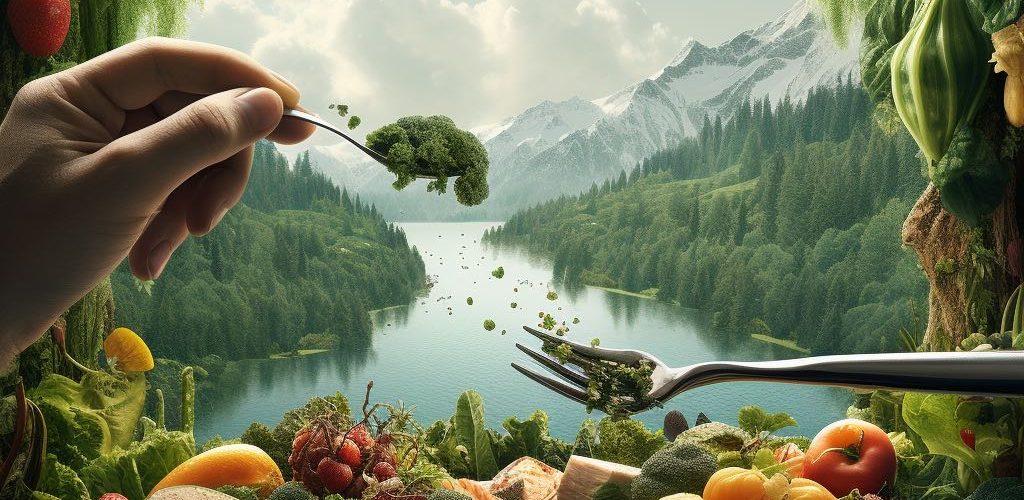
One of the big questions surrounding the topic of diet is — what are humans supposed to naturally eat?
Questions of anthropology always have a bit of mystery to them. Without a time machine, it’s hard to know conclusively what happened at the origins of humankind. All we can do is look at the evidence we do have. Perhaps our observations will not be conclusive or will be nuanced with a bit of grey area, without it being so black and white. You need to trust your own intuition about where our species likely originated and what we are most fit for, and also observe the scientific facts.
This question of our roots explains a phenomenon like the paleo diet, consisting of meat, cooked vegetables, nuts and raw fruits and vegetables, which assumes that ancient humans were hunting animals, cooking and eating their meat and cooking vegetables, but were not farming grains and processing them into breads, or making other processed foods.
There is of course evidence that certain groups of humans, based on archeological findings, were fashioning tools and hunting down animals to eat them. There is no doubt in my mind this happened in ancient history throughout many different areas.
Part of this is also a question regarding geology and ethnicity. Most anthropologists agree that the human species originated within the continent of Africa. At some point, some humans decided to migrate north into Europe and eventually Asia, over the Bering Straight and across Alaska into the Americas. This can help explain why the pigment of some groups of skin turned more fair, being in certain colder areas with limited sun.
You also can observe how different ethnic groups have different digestive processes and different tolerances for various foods and compounds. For example, more fairer-skinned ethnicities break down complex sugars in dairy and alcohol quicker than their darker-skinned contemporaries. This may or may not be due to many millennia of eating a more higher-protein diet of animals, and fermented alcohol-type drinks, that were stored and used as fuel during extreme cold weather, as compared with darker-skinned humans who lived in more tropical climates with more fresh plants available to cultivate and eat.
All this being said, there’s no question that humans wasted little time to start exploring and experimenting with consuming different foods, including hunting animals and making alcohol — but what foods are we really designed for? After all, a cat is carnivorous, but you could feed it a plant-based diet and it would still theoretically stay alive. A cow is an herbivore, and if you fed it meat or dairy products, it could theoretically stay alive as well.
Let’s address a few of the foods most commonly consumed by humans, and take a closer look to see how biologically we are set up to eat them:
There is no animal on planet Earth that consumes dairy past the point of being a baby. The issue with consuming dairy once you grow older is that our body changes and is much less compatible with it. Up until the age of three, humans secrete enzymes called Rennin and Lactase, which break down lactose, a complex sugar contained in mothers’ milk. After that age, this enzyme is no longer secreted, and lactose gets broken down mostly by fermenting within the body, without the necessary enzymes to digest it efficiently. This is one reason why so many people experience digestive issues with dairy.
It seems like dairy would be a very labor-intensive food for ancient humans to produce. It would have required proper raising of livestock, and much resources to contain the animals and breed them. This would have required significant organization, but it seems possible that certain ancient populations of humans may have had the resources and sophistication to do this.
How about grains and beans, within the scope of the anthropologic roots of humans? Because humans have only been cultivating food (farming) for about 8,000 to 10,000 years, and our species is far older than that, we could deduct with high probability that in the beginning times, humans were not growing, refining, or cooking grains or beans. When consumed raw, these foods are simple not appetizing, nutritious or able to be digested effectively — at least not by humans (covered more extensively in a later chapter).
We can reasonable conclude that humans ate fresh fruits, as well as fresh vegetables, nuts and seeds. Fruits, vegetables, nuts and seeds grow abundantly in the tropical and even subtropical areas of Africa. It is beyond obvious that, if these plants were sitting there in the nature environment, humans would have sustained themselves on these foods.
As far as cooked vegetables, this is a distinct possibility, also depending on the development of the group of humans at a certain time and place. Creating a fire may have been a big task, depending on the civilization or tribe. Certain vegetables we do know are tough to eat raw, but can be softened up and much more easily eaten when cooked. Perhaps we can presume that these tougher vegetables may not have been consumed very often for humans that didn’t use fire.
In terms of meats, there is evidence that ancient humans did hunt it and eat it, at least in some contexts, historical ages, and geographies. Raw meat is not too appetizing when you really think about it, so eating meat would seem to be more limited to people who could create and cultivate fire, as well as having tools to skin and prepare the animal for roasting. Raw fish & eggs could be an exception to this, because even today this can still be considered delicacy — for that matter, humans may have also eaten raw grubs and other insects.
Going beyond the practicality and the mechanics of what it would take to eat these different foods, let’s take a look at the design of human biology, in comparison with other types of animals:
Let’s look at the four types of vertebrates and compare their digestive systems and the types of foods they eat.
— Group 1: Big cats
— Group 2: Birds, Dogs & Wild Hogs
— Group 3: Deer, Cattle, Sheep, Horses
— Group 4: Primates & Humans
Let’s take a closer look at these groups:
Group 1: Big Cats:
These are big cats, and they eat mostly meat, while also eating some grass and herbs.
Examining their mouth, they have a rough tongue, with jaws moving in an up-and-down direction only, and sharp incisor teeth in front, canine teeth, and molars in the back — this design helps tear apart their food. They have no salivary glands.
Their stomach is a simple structure that emits strong gastric juices. Their liver — which is about 50% larger than a human liver — is complex with five chambers and involves a heavy flow of bile to aid protein digestion.
The cats’ GI tract is short, only three times the length of their spine, and their colon lacks the absorbing lining found in humans — in other words it is smooth and doesn’t absorb as much.
Group 2: Birds, Dogs & Wild Hogs:
Their diet is diverse, and includes meat, vegetables, fruits, and other miscellaneous foods.
They have a moderately rough tongue and have salivary glands which are not very active. They have multi-directional jaws. Dogs have sharp canine teeth. Birds have beaks of course.
Their stomachs emits a moderate amount of gastric acids. Their liver is also complex and is significantly larger than human livers. Their GI tract is 10 times longer than their spine. Their colon is shorter than the colon of a human and only can absorb nutrients somewhat.
Group 3: Deer, Cattle, Sheep, Horses:
These are the grazers, and their diet consists of vegetables and herbs, as well as some other plant matter like some roots.
We see that they have multi-directional jaws which can create a grinding affect on the food. They have cutting teeth in front and molars in the back. They have active salivary glands and a tongue that is decently rough.
Their stomach is extremely complex, having four or more areas, with weak amount of stomach acids being excreted. Their liver is only slightly larger than human livers. Their GI tract is 30 times the length of their spine, with their small intestines being long and having soaking up qualities to it. Their colon is long and filled with absorbing rings as well, allowing for maximum absorption.
Group 4: Primates & Humans
There’s no question that humans most resemble primates closer than any other species, with our DNA matching a Chimpanzee about 98%.
Let’s take a look at what the primates eat, such as chimpanzees, monkeys, apes, gorillas, etc. We’re not going to focus on what humans eat because we’re not really observing humans anymore in their natural habitat. We all know what humans eat nowadays — Oreos, Doritos, & Hot Dogs from the 7-Eleven grill.
These natural primates eat mostly fruits, vegetables, nuts and seeds, and occasionally some other things like bugs. The vast majority of primate species never eat any animal meat at all. There are a select few groups of primate species that do occasionally eat bird eggs, baby birds & the meat of small animals like reptiles, although their diet still mainly consists of plants.
The mouth of primates includes jaws which are multi-directional, and a complex system of teeth, with 8 incisor teeth, 4 pointed teeth, and twelve molars. The tongue is smooth and the salivary glands are active.
The stomach is oblong and has two compartments. The liver is roughly the same size in both humans and primates, and is not complex. The GI tract is 12 times the length of the spine (longer than the carnivores but shorter than the herbivores, significantly). The small intestines and large intestines are ringed and also allow for maximum absorption.
It might be worth mentioning that both primates and humans have hands with fingers that can be used for gathering and opening up foods, and both species (for the most part) walk on two feet.
In Conclusion:
After I learned this information, it became rather obvious to me that humans are biologically suited for eating mostly if not all fruits and vegetables, nuts and seeds.
It doesn’t mean we have to eat these foods — it’s more just a question of what we are suited for in terms of biology. This is sort of like making the argument that we are a tropical species, suited for warm weather. A human can still live in a very cold environment — he or she is just living in such as way that is adversarial to what they are suited for.
A family dog can survive on a diet of breads, chips, Hot Pockets, pizza and cookies, and might even continue on for many years eating these foods and carry on quite happily for a white. But this canine would still be eating against its own nature. In fact most dog foods are full of junk and toxins and dogs still tolerate it.
So this is not an exploration of what human beings can tolerate eating. We know that our body is very robust and can withstand quite a lot of different types of foods and even abuse and still function. We will explore more in other sections about what are the best foods to eat and the consequences of eating various foods.
I hope this simply creates some context about where our human species fits onto Planet Earth, biologically, anthropologically, and within the grand scheme of where this whole crazy thing started out. Upon gaining some insight into that quandary, we can now try to figure out the big question — what should we eat in these strange, modern times?
